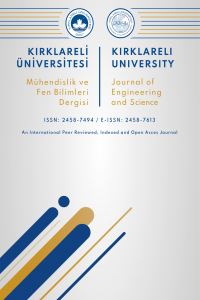SURFACE QUALITY COMPARISON BETWEEN TRADITIONAL AND ONE STEP PRODUCTION CYCLE
Surface defects for painted parts
SURFACE QUALITY COMPARISON BETWEEN TRADITIONAL AND ONE STEP PRODUCTION CYCLE
Surface defects for painted parts,
___
- Referans 1: Mitzler J., Dykhuis M., Reuter S., Schelter D. (2014). One Surface, Three Effects. Kunststoffe International, 9, 41-44.
- Referans 2: Mitzler J., Dykhuis M., Moch t., Gerndorf R. (2014). An Affordable Alternative to Conventionally Painted Parts. Kunststoffe International, 10, 85-88.
- Referans 3: Kienzl W., Fischer M., Steinbichler G., Plinke S., Kralicek M. (2016). High Quality Interior Components at Low Unit Cost. Kunststoffe International, 12, 43-45.
- Referans 4: Hanson A. R. (2006). Measurement Good Practice Guide No.94. Teddington: Crown.
- ISSN: 2458-7494
- Yayın Aralığı: Yılda 2 Sayı
- Başlangıç: 2015
- Yayıncı: Kırklareli Üniversitesi
HIZLI PROTOTİPLEME YÖNTEMLERİ İLE ÜRETİLEN OTOMOBİL PARÇALARININ ÜRETİM HIZLARININ KARŞILAŞTIRILMASI
MAPPING FIRE INCIDENTS AND EVALUATING SERVICE AREA OF FIRE STATIONS IN FATIH SUBPROVINCE
BİLGİ GÜVENLİĞİ TEHDİTLERİ: YAZILIM TANIMLI AĞLAR GELENEKSEL BİLGİSAYAR AĞLARINA KARŞI
SURFACE QUALITY COMPARISON BETWEEN TRADITIONAL AND ONE STEP PRODUCTION CYCLE
Sevil DEMİRCİ, Semih ERTÜRK, Uğur ÜZEL
AN OVERVIEW ON TOPOLOGY OPTIMIZATION METHODS EMPLOYED IN STRUCTURAL ENGINEERING
KÖFTE MATRİKSİNDE İKİ FARKLI BESİN PATOJENİNE KARŞI FARKLI BAHARATLARIN ANTİMİKROBİYAL AKTİVİTESİ
TÜRK-İSLAM MEDRESELERİ VE BUDİST VİHARALARI ÜZERİNE BİR İNCELEME
GÜÇ TRANSFORMATÖRLERİNİN YILDIRIM DARBE ANALİZLERİNİN ANSYS@MAXWELL-3D İLE GERÇEKLEŞTİRİLMESİ
Yıldırım ÖZÜPAK, Mehmet Salih MAMİŞ, Taner GÖKTAŞ, Müslüm ARKAN
